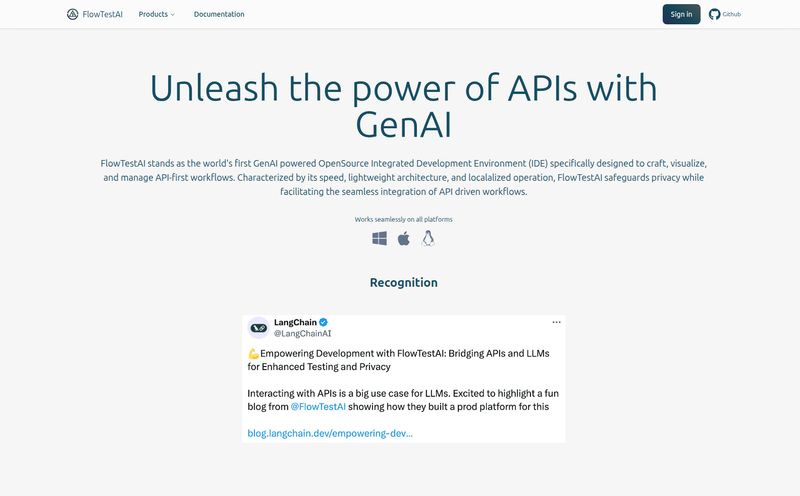Technical hiring can be a total nightmare. For years, it’s been this strange ritual where we ask incredibly smart software engineers to solve abstract puzzles that have little to do with building actual software. You know the drill. Whiteboarding binary tree traversals for a front-end developer role. It’s like asking a world-class chef to prove their skills by… I don't know, peeling a thousand potatoes with a spoon. You learn something, I guess, but it’s not what you really need to know.
I’ve been in this industry for a long time, and I've seen countless tools promise to fix this. Most of them just put a prettier UI on the same old problem. So when I came across a platform called Ropes, I was skeptical. Another AI-powered doohickey? Great. But the more I looked, the more I realized it might actually be onto something. Especially for my friends in the staffing and recruitment world.
What Exactly is Ropes? (And Why Should You Care?)
At its core, Ropes is an AI-powered platform for screening engineering candidates. But hold on, don’t click away yet. It’s not just another auto-grader. The entire premise is to move beyond simple “pass/fail” test cases and evaluate a candidate's skills in a way that feels more… well, human.
The landing page calls it “The AI Revenue Engine for Staffing Firms.” That’s a bold claim, but it tells you exactly who they’re talking to. This isn’t just for a FAANG company’s internal HR department; it’s built for the high-stakes, fast-paced world of technical placements where quality and speed mean everything. It aims to give you a realistic picture of a candidate's talent, not just their ability to cram for a test.

Visit Ropes
Think of it as the difference between a written driving test and an actual on-the-road exam. One checks for memorized knowledge, the other checks if you can actually drive without hitting a curb. Ropes is trying to be the on-the-road exam for coders.
The Features That Actually Matter
A feature list is just a list until you see how it solves a real problem. And Ropes has a few features that made me sit up and pay attention because they address some of the biggest headaches in tech recruiting.
AI-Generated Problems from Real Job Needs
This is probably the coolest part. We’ve all struggled to come up with relevant interview questions. You either reuse the same old ones or spend hours crafting something new. Ropes lets you generate environment-based problems directly from a client’s job description, your own notes, or even call recordings. This is a massive shift. Instead of asking a candidate to solve a generic algorithm puzzle, you can give them a challenge that mirrors the actual work they’d be doing. That’s how you find out if someone can really do the job.
Fighting the Cheaters (And Winning)
Oh, the cheating. It’s rampant. With remote assessments, it’s just too easy for someone to have a friend on a Discord call or just copy-paste a solution from Stack Overflow. Ropes seems almost obsessed with fraud prevention, which I love. The platform flags things like multiple client-reported IPs or suspicious screen resolutions. But it goes deeper, with what they call “AI-based cheating detection.” It looks for signals beyond simple copy-paste, creating a more robust integrity check. For a staffing firm, placing a fraudulent candidate is a disaster. This feature alone could be worth its weight in gold.
Scorecards That Tell a Story, Not Just a Score
A pass/fail grade is almost useless. I once interviewed a candidate who failed the coding challenge but his thought process was brilliant. We hired him, and he was a star. Ropes gets this. It provides detailed, holistic scorecards that show how a candidate arrived at their solution. It's designed to let you evaluate their approach, their problem-solving skills and their efficiency. This is the kind of insight you’d normally only get from a time-consuming pair programming session.
Full Transparency with Candidate Traceability
Here's one for the agency folks. How do you prove to a client that your candidate is the real deal? Ropes provides traceability. It logs pretty much every action a candidate takes during the assessment—every copy-paste, file update, and how much time they spent on different parts of the problem. You can literally show your clients the candidate’s entire work process. That builds an incredible amount of trust and makes your job of selling that candidate so much easier.
So, Is It Actually Better Than the Old Way?
No tool is a magic wand. From what I can gather, there are clear upsides and a few things to keep in mind.
The big advantage is the realism. You’re getting a much clearer signal on a candidate's actual, on-the-job coding skills. The cheat prevention is a huge plus, and the detailed scorecards allow for genuinely data-driven hiring decisions that go beyond a simple score. Creating custom problems tailored to specific roles is, in my opinion, how all technical screening should be done.
On the flip side, a powerful tool requires some effort. You’ll likely need to spend some time on setup and customization to get the most effective assessments. It's not a fire-and-forget solution. And, like any AI-powered system, its effectiveness is tied to the quality of the underlying model. It's a leap of faith to some degree, betting that their AI can evaluate talent as well as a seasoned engineer. Some will argue it can't, but I'd argue a tired, biased engineer conducting their fifth interview of the day isn't a perfect system either.
What's the Damage? A Look at Ropes Pricing
Naturally, I went looking for a pricing page. And… it’s not there. The `/pricing` URL on their site leads to a 404 page (I see what you did there, Ropes). This isn't surprising, really. For a B2B SaaS platform targeting agencies and enterprise clients, pricing is almost always custom.
This usually means they operate on a “request a demo” model, where the cost depends on your company’s size, usage volume, and the specific features you need. They have a big “Try it risk-free” call to action, so your best bet is to get in touch with them directly. Don't expect a simple three-tiered pricing chart.
My Final Take on Ropes
I'm cautiously optimistic. Tech recruiting has been stuck in a rut for ages, and it’s refreshing to see a company tackling the right problems: realism, cheating, and providing deep, actionable insights. The focus on staffing firms is smart, as they feel the pain of bad placements most acutely.
Ropes isn't just automating the old, broken process. It's trying to build a new, better one. It’s using AI not just to check a box, but to, ironically, make the evaluation more human by focusing on process and thought instead of just the final answer. It won't be for everyone, and it won't solve every hiring problem, but it’s a significant step in a direction our industry desperately needs to go.
Frequently Asked Questions about Ropes
- Who is Ropes best for?
- It seems tailor-made for technical staffing and recruitment firms. However, any internal hiring team that’s frustrated with traditional coding tests and wants a more realistic assessment process would find it valuable.
- How does Ropes prevent cheating in coding tests?
- It uses a multi-layered approach. This includes tracking technical signals like IP addresses and screen resolutions, logging candidate actions like copy-pastes, and employing an AI model to detect suspicious behavior patterns during the assessment.
- Can I create my own custom coding problems in Ropes?
- Yes, absolutely. This is one of its main strengths. You can create custom problems from scratch or use its AI to generate them based on inputs like a job description, project documents, or even meeting notes.
- Is Ropes just another automated code checker?
- No. While it does check code, its primary goal is to evaluate how a candidate solves a problem. The scorecards focus on the process, traceability, and overall problem-solving approach, not just whether the code passes a set of predefined tests.
- Is Ropes difficult to set up?
- Like any powerful business tool, expect a learning curve. The platform's value comes from its customization and depth, so you'll need to invest some time in setup to create assessments that truly match your needs. It’s not a simple plug-and-play solution.
Hiring the right people is one of the hardest things any company does. For too long, we’ve relied on proxies for skill instead of measuring the skill itself. Maybe, just maybe, tools like Ropes are the start of changing that for good.



